

Mariachis
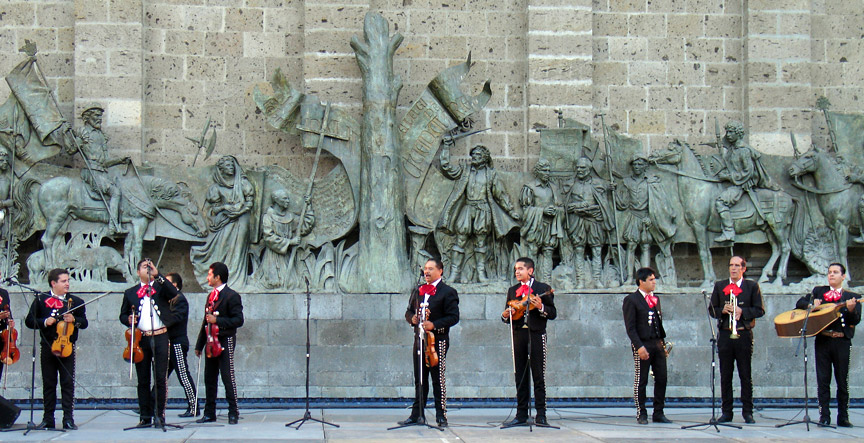
Mariachis in front of the Frisa de los Fundadores in Guadalajara, Mexico
The Wedding of Musical Traditions
Prior to the arrival of Cortes the music of Mexico, played with rattles, drums,
reed and clay flutes, and conch-shell horns, was an integral part of religious
celebrations. Quickly, however, as Christianity spread, in many areas these
instruments gave way to instruments imported by the Spanish: violins, guitars
and harps, brass horns, and woodwinds. The Indian and mestizo musicians not only
learned to play European instruments, but also to build their own, sometimes
giving them shapes and tunings of their own invention.
Music and dance were important elements of Spanish theatrical productions,
enormously popular throughout the Spanish speaking world during the colonial
period. The typical Spanish theatrical orchestra of the sixteenth, seventeenth,
and eighteenth centuries was comprised of violins (usually two), harp and
guitars (or guitar variants). It was from this group that several of the most
distinctive regional ensembles of Mexico developed, including the Mariachi.
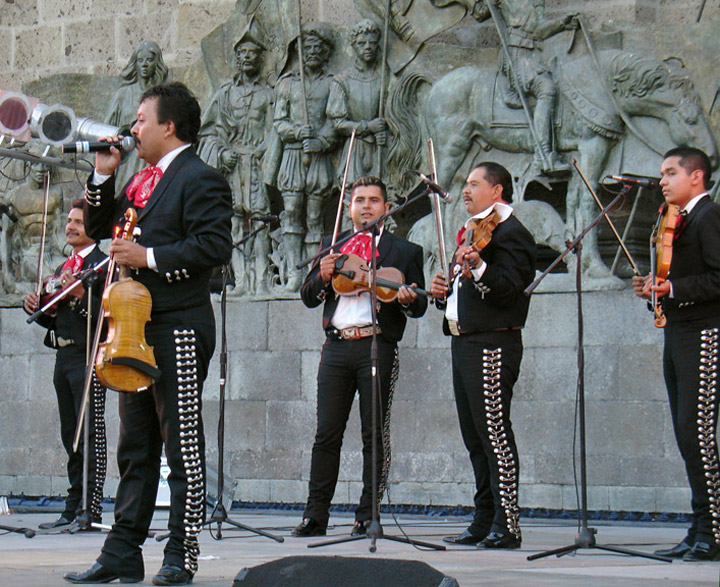
singing and playing
To View short clips of their concert
Mariachi - What Does It Mean?
Musicologists and folklorists have argued for years over the origin of the word
- Mariachi.
The explanation that appears most frequently - especially on record jackets and
in travel brochures - is that it is a variation of the French word mariage,
meaning wedding or marriage, and comes from the time in the nineteenth century
when Maximillian, a Frenchman, was Emperor of Mexico. According to this myth the
Mariachi was named by the French after the celebration with which it was most
commonly associated. But this explanation, always regarded as highly doubtful by
linguists, was totally discredited recently when a use of the word was found
that predated the time when the French arrived in Mexico.
Currently, however, the best scholarly opinion is that the word mariachi has
native roots. One theory is that it comes from the name of the wood used to make
the platform on which the performers danced to the music of the village
musicians. But whatever its true source - and the truth may never be discovered
with absolute certainty - the word today has one meaning that is crystal clear:
Mariachi means on of the most exciting and enchanting musical ensembles found
anywhere in the world.
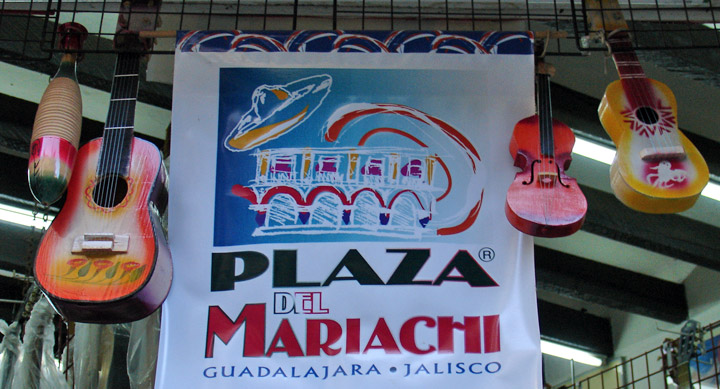
Where the Mariachi groups come to be hired
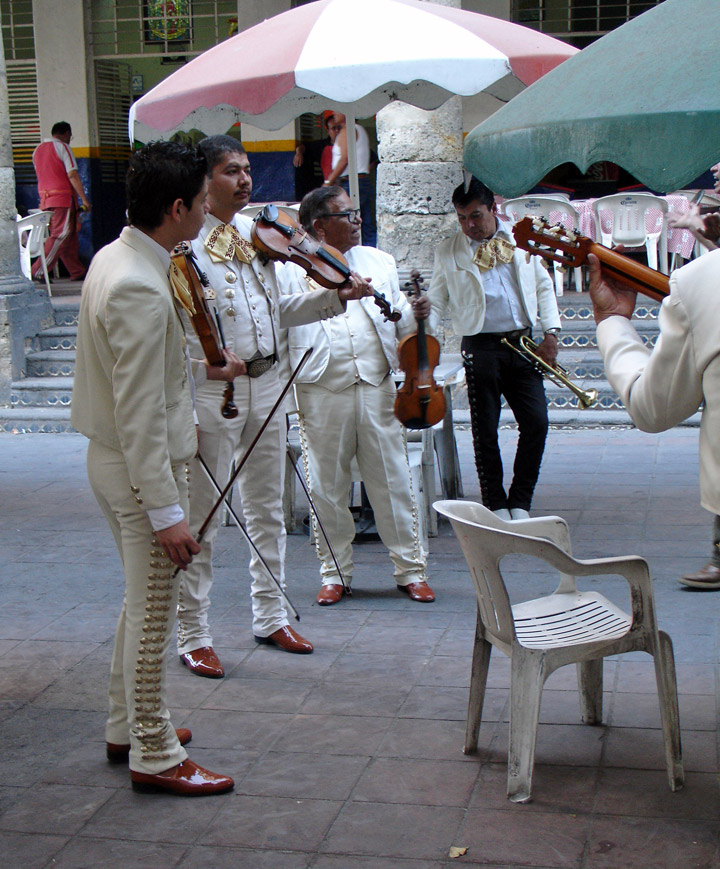
ready for an audition
The Unique Make-Up of the Mariachi Ensemble
In the complete Mariachi group today there are as many as six to eight violins,
two trumpets, and a guitar - all standard European instruments. Then there is a
high-itched, round-backed guitar called the vihuela, which when strummed in the
traditional manner gives the Mariachi its typical rhythmic vitality; a
deep-voiced guitar called the guitarrón which serves as the bass of the
ensemble; and a Mexican folk harp, which usually doubles the base line, but also
ornaments the melody. While these three instruments have European origins, in
their present form they are strictly Mexican.
The sound that these instruments combine to make is unique. Like the sarape,
which often used widely contrasting colors side by side - green and orange,
yellow and blue - the Mariachi used sharply contrasting sounds: the sweet sounds
of the violins against the brilliance of the trumpets, and the deep sound of the
guitarrón against the crisp, high voice of the vihuela; and the frequent
shifting between syncopation and on-beat rhythm. The resulting sound is the
heart and soul of Mexico.
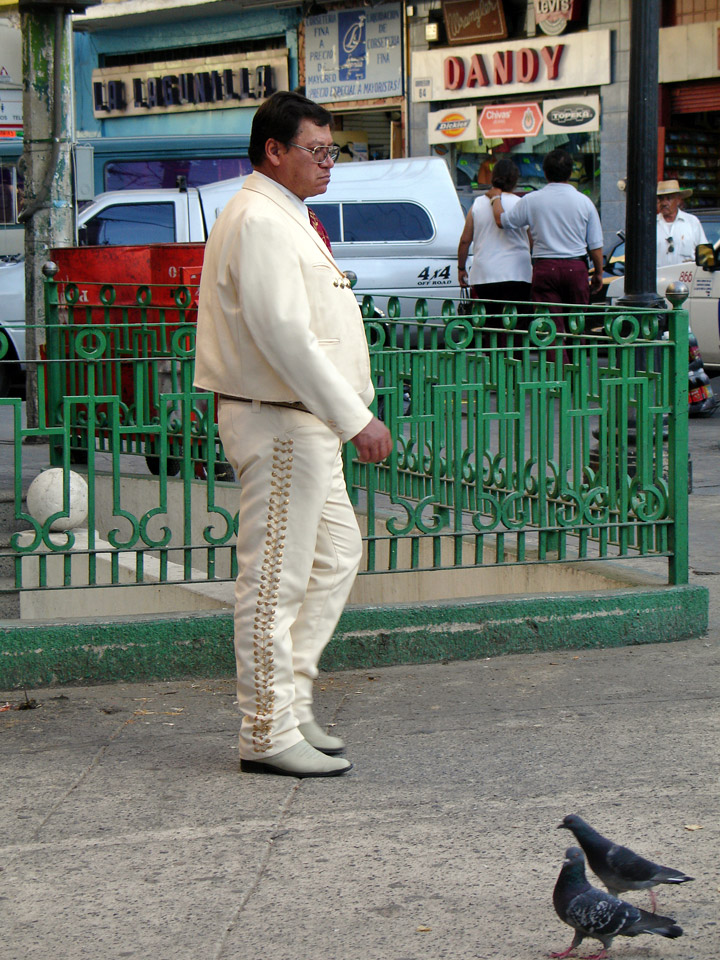
waiting to be hired
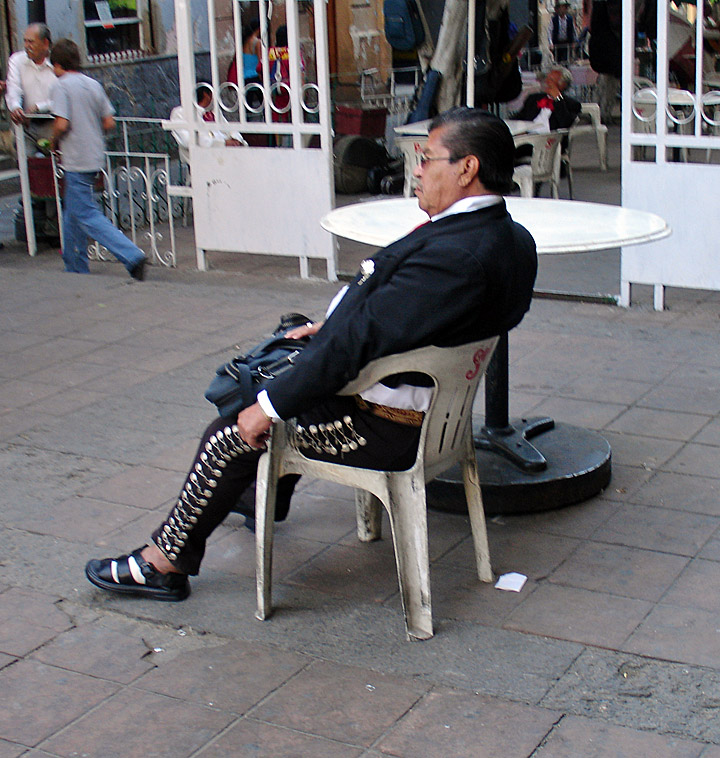
at the Mariachi Plaza in Guadalajara
The Beginning of the Mariachi We Know Today
Although the origins of Mariachi music go back hundreds of years, in the form we
know it the Mariachi began in the nineteenth century in the Mexican state of
Jalisco - according to popular legend, in the town of Cocula. The Mariachi was
the distinctive version of the Spanish theatrical orchestra of violins, harp and
guitars which developed in and around Jalisco. In other areas such as Veracruz
and the Huasteca region in the northeast, the ensemble evolved differently. By
the end of the nineteenth century, in Cocula the vihuela, two violins, and the
guitarró n (which had replaced the harp) were the instruments of the Mariachi.
The principal music played by these early Mariachis was the son, the popular
music of the day. A mixture of folk traditions from Spain, Mexico, and Africa,
the son was found in many regions of the country. The son from Jalisco is called
the son jalisciense. La Negra is the best-known example.
Sones from other regions include the son jarocho or veracruzano, from the region
around the Gulf port of Veracruz; and the son huasteco, from northeastern
Mexico. The most famous example of the son jarocho is La Bamba . A typical son
huasteco, also known as the huapango, is La Malagueñ a. It is interesting to
note that there are some sones, such as El Gusto, which are common in all three
regions and clearly date back to a common ancestor.
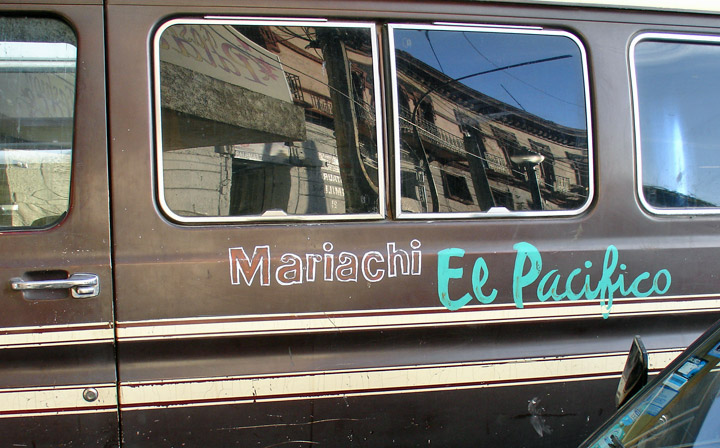
the van for "El Pacifico" which is used to go to playing jobs
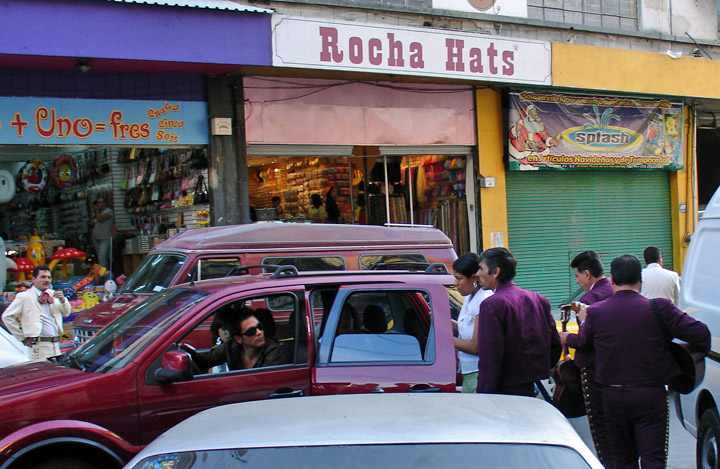
making an arrangement for a job with a passing motorist
Mariachi and Dance
It is important to remember the son-and other types of Mariachi music- is not
just music to be played and sung. From the very start it was music to be danced.
The traditional dance technique associated with both the son jalisciense and son
jarocho is the zapateado, a distinctive type of footwork that originated in
Spain. When dancing the zapateado the performers skillfully drive the heels of
their boots or shoes into the dance-floor, pounding out swift, often syncopated
rhythms which complement the different rhythm of the musical instruments. The
zapateado can literally reduce even the most resistant dance floor to splinters
because of the force with which it is danced.

prepared to play
Each of the regional variations of the son has its traditional style of dance.
The huapango or son huasteco, for instance, like the son jalisciense and son
jarocho, was originally danced on wooden platforms, in some areas mounted on
earthen jugs. To dance the huapango the couples line up in opposing columns. The
upper part of the body is held perfectly erect as the feet perform rapid,
intricate, shuffling maneuvers. Today it is sometimes performed with a glass of
water on the head to show off the dancer's incredible muscular control.
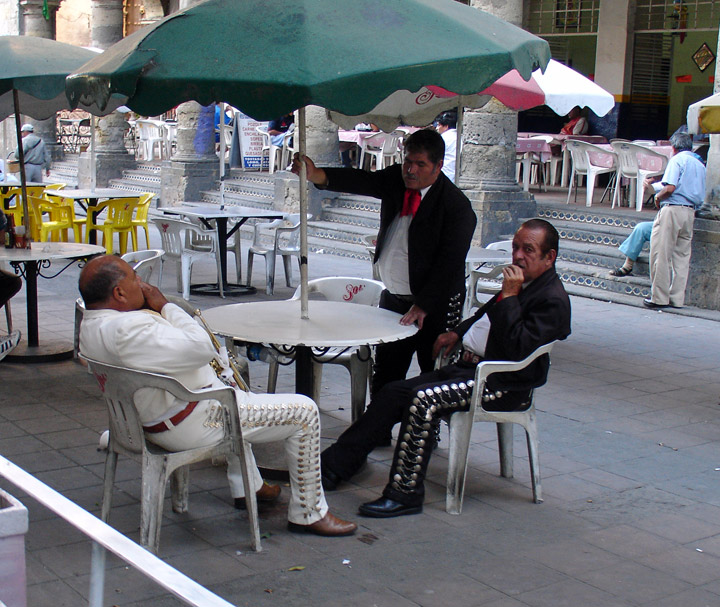
waiting
The lyrics of the sones frequently describe country life: in particular, the
plants, animals and people of the region. These lyrics are highly suggestive,
often using imagery of the courtship of farm animals to describe the relations
of men and women. In the dance the movements of the performers often represent
the farm-yard courtship described in the verses of the sones.
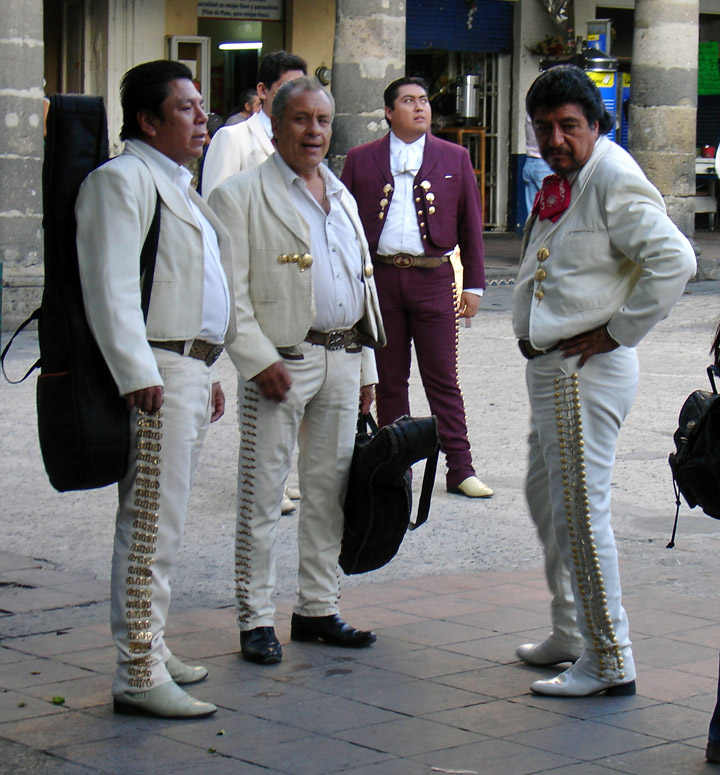
Another kind of music related to the son and intimately connected with a
particular dance is the jarabe. The jarabe, which has many regional variations,
is really a medley of dance pieces, including sones, danzas, jotas, and polkas.
No discussion of Mariachi dance would be complete without mentioning the famous
Jarabe Tapatio - the Mexican Hat Dance. Associated with Guadalajara in the state
of Jalisco, it has become the national dance of Mexico. It is highly stylized,
with prescribed movements and costumes. The male wears the classic outfit the
Jalisco horsemen or charro, while the female the China, wears a hand-woven shawl
and a bright sequined skirt.
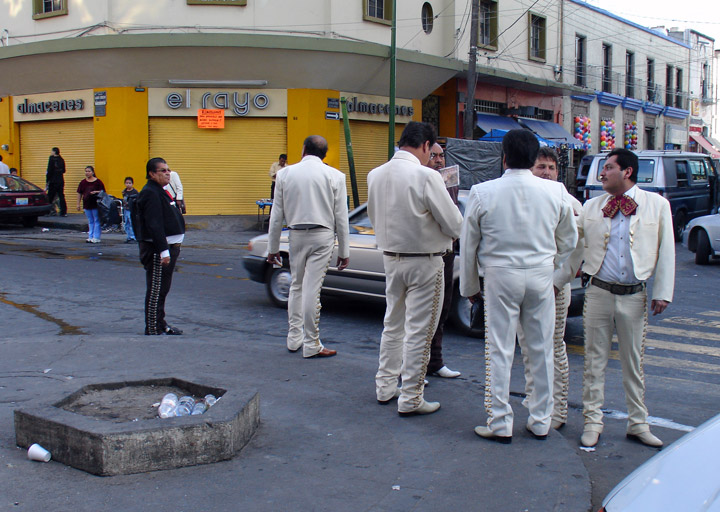
waiting to be hired
By the 1930's Mariachi musicians had begun wearing the same traje de charro,
consisting of a waist-length jacket and tightly fitted wool pants which open
slightly at the ankle to fit over a short riding boot. Both pants and jacket are
often ornamented with embroidery, intricately cut leather designs, or silver
buttons in a variety of shapes. Prior to the 1930's, photographs show early
Mariachis dressed in calzones de manta, and huaraches, homespun white cotton
pants and shirts and leather sandals, the clothes worn by most peasants in
Jalisco.
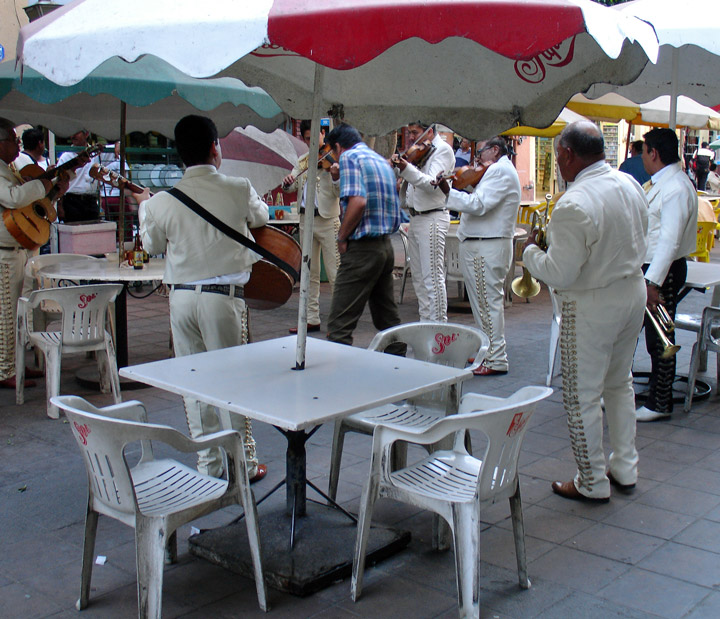
playing in the Plaza
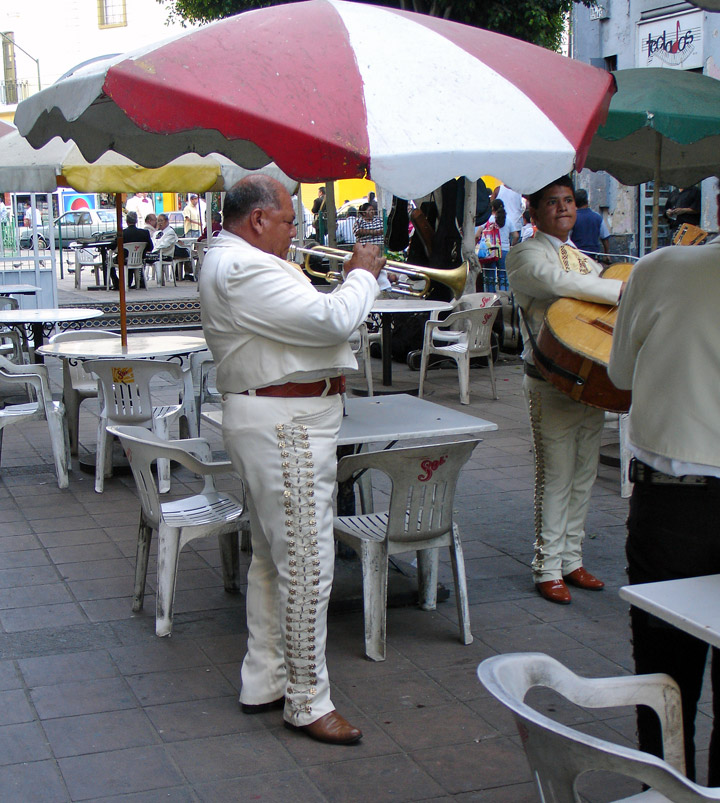
the trumpet
Coming of Age: Mariachi Vargas
Although the roots of the Mariachi go back hundreds of years, there are no Bachs
or Beethovens in its early history because Mariachi music was the music of
country people. Until the 1930's Mariachi groups were local and
semi-professional. They were almost entirely unknown outside their own region.
This began to change about 60 years ago, when the Mariachi Vargas de Tecalitlán
n, founded by Gaspar Vargas in 1898, went from Jalisco to Mexico City. They were
invited to play at the inauguration in 1934 of populist President Lá zaro
Cárdenas, one of whose great interests was to foster the native culture of
Mexico. Catching the Presidents enthusiasm, urban sophisticates took the folk
arts to their hearts, and the Mariachi Vargas instantly became the toast of the
town. The initial success was only the beginning. Silvestre Vargas, who had
taken over from his father as leader of the Mariachi Vargas in 1928, soon hired
a trained musician, Rubín Fuentes, as musical director.

Fuentes, still actively involved with the Mariachi Vargas more than fifty years
later, is one of the towering figures in the development of the Mariachi. With
the help of Silvestre Vargas, he standardized the arrangements of many of the
traditional sones composed many exceptional new huapangos, and wrote
arrangements for many of the legendary song writers and singers of his
generation, including Pedro Infante, Miguel Aceves Mejía, Lola Beltrán, and José
Alfredo Jiménez. By the 1950's he insisted that all his musicians read music.
These innovations changed the way Mariachi music moved from one group to
another. Gone was the total reliance of the musicians on their ears to pick up
new songs, and techniques.
With this giant step toward professionalism coinciding with the development of
recordings, radio and film, the Mariachi Vargas was able to become the ideal
that all other groups would emulate. With the addition of two trumpets, a
classical guitar and more violins, by the 1950's the Mariachi ensemble had
become a complete, adaptable orchestra, with the ability to retain its
traditional base while it was assimilating new musical ideas and styles. The
importance of Mariachi Vargas cannot be overestimated. Its arrangements have
become the definitive statements of what the Mariachi should be.
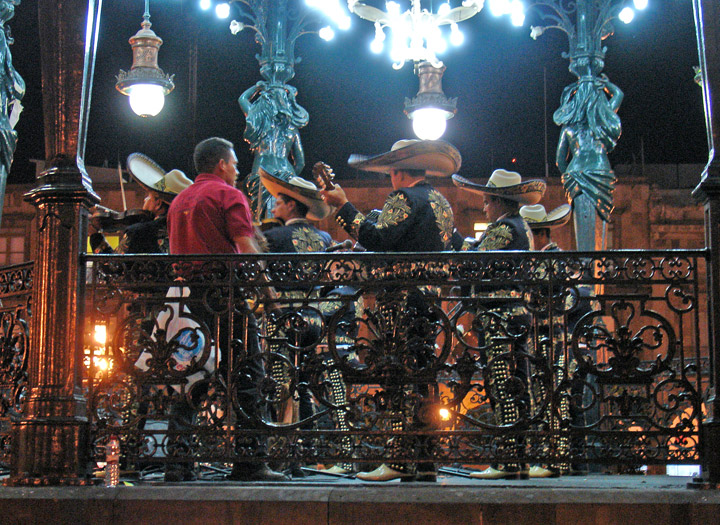
band stand in the Plaza de Armas, Guadalajara, Jalisco, Mexico
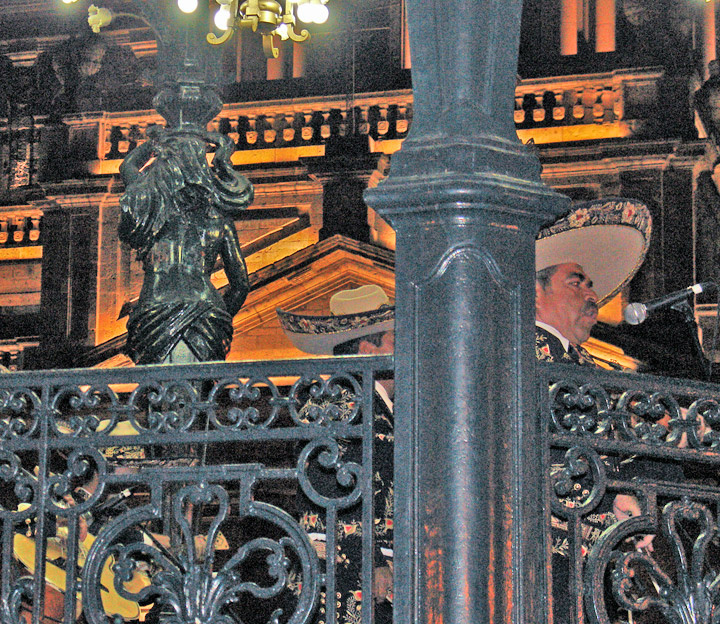
Wednesday at 8:00 PM
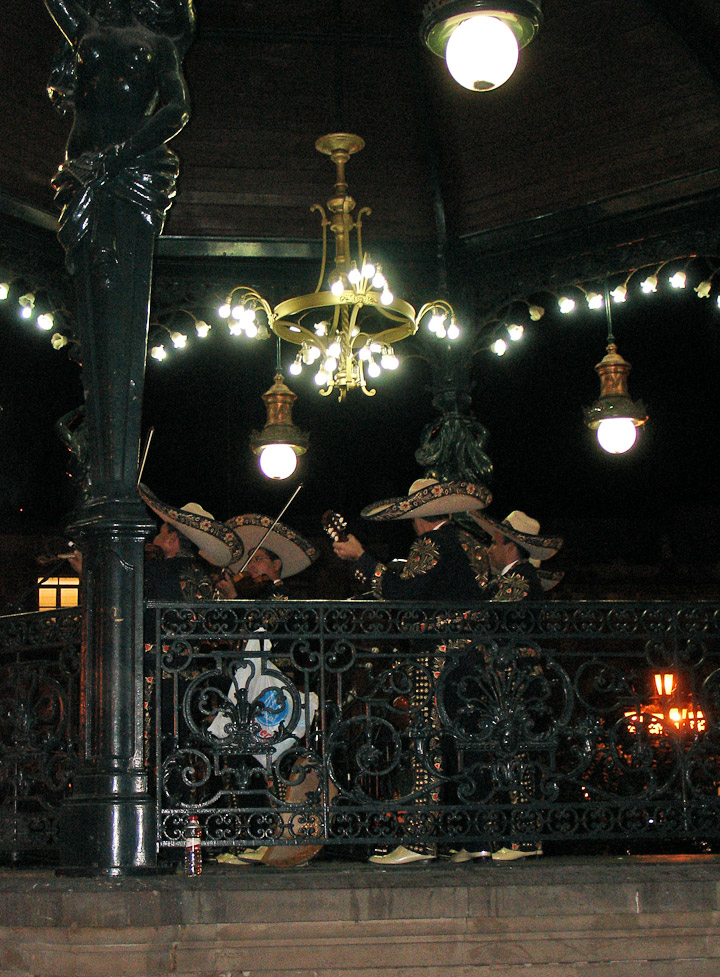
The Mariachi at Special Occasions
Mariachis often help celebrate the great moments in the lives of the Mexican
people. With the serenata (serenade), the Mariachi participates in the rite of
courtship. In a society where the young members of opposite sexes were kept
apart, the serenata was a means of communication by which a young man could send
a message of love to the woman of his heart. In many areas of Mexico, it is not
unusual to be awakened by the sound of Las Mañ anitas, the traditional song for
saints days, or birthdays. The Mariachi is usually positioned strategically on
the street beneath the window of the festejada, but the sound of its music
echoes through the whole neighborhood. Mariachis are also commonly hired for
baptisms, weddings, patriotic holidays, and even funerals. It is not unusual for
the deceased to leave a list of favorite songs to be sung beside the grave at
burial.
Mariachi music has been incorporated into the Roman Catholic Church's most
sacred ritual: the Mass. The Misa Panamericana is a Mariachi folk mass, sung in
Spanish, that uses traditional instruments to create vivid new interpretations
of the traditional elements of the service: Angelus, Kyrie eleison, Gloria,
Alleluia, Offertory, Credo, Sanctus, and Agnus Dei.
The first Mariachi Mass was the concept of a Canadian priest, Father Juan Marco
Leclerc, and has been celebrated in Cuernavaca since 1966. It originally took
place in a small chapel, but news of it spread so rapidly, and the crowds grew
so large, that the regular Sunday Mariachi Mass had be moved to the Cathedral of
Cuernavaca. It is now frequently performed throughout Mexico, and In many areas
in the United States where people of Mexican origin live.
History of the Mariachi - Excerpts from --- Mexico, The Meeting of Two Cultures 1991 Higgins and Associates, New York, NY for The 7-Eleven Hispanic Arts Festival (Arts for Business)
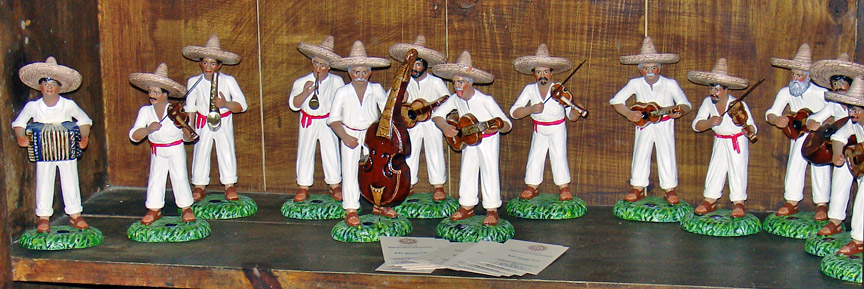
figures of musicians